Coaches play a big role in educating their players about the language (ex. Forechecking, Backchecking, Breakout, Deking) used in the world of ice hockey. That’s why we’ve created a useful tool for you! – The Hockey Glossary package. To access Hockey Glossary, simply sign in to your HCV app (whether with a Player, CoachLimited, or Full Coach Account) and download the package from the FREE folder.
What is the Hockey Glossary?
The Hockey Glossary is a summary of terminologies that are often used in the Ice Hockey Eco System. The terms range from rules, skills, tactics, and techniques or they can be generally about the sport of hockey. (ex. Forechecking, Backchecking, Breakout, Deking) Feel free to explore all terms to learn how to talk hockey. 😎
The glossary ensures that all players receive consistent and accurate information, reducing the chances of misunderstandings on the ice. Sharing a hockey glossary with your team will promote a common understanding among players, which can enhance teamwork and decision-making during games. This over many years developed language not only educates but also engages athletes, helping them perform at their best on the ice!
Players can access Hockey Glossary on their smartphones at any time, whether they’re on the bus, at home, or in the locker room. Not every term needs to be known on every level, that’s why they are separated by level filters. Make sure your players know them when they get to a certain age!
Hockey Glossary
(2D & 3D animated files of each term available for FREE in your HCV app)
Angling:
In this classic angling example, the first player in on the forecheck (F1) angles the puck carrier to one side of the ice towards the boards away from the middle ice. The objective is to force the puck carrier into a tight area and cause him to turn over the puck.
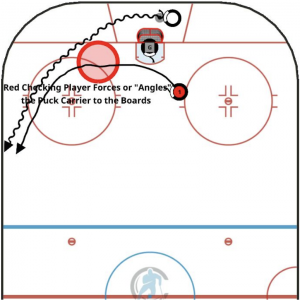
Back Door Pass/Player:
The “Back Door” in Hockey Glossary refers to the open side of the net that is on the far side away from the puck carrier. The goalie cannot protect both sides of the net, so they must first protect against the near side shot, leaving their “back door” open. “back door pass” refers to a pass from the goalie’s strong side(P1) to the player behind him (P2) near the exposed side of his net.
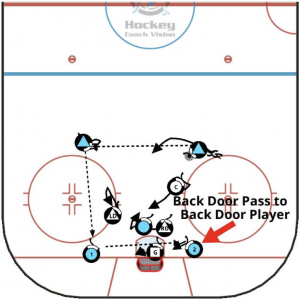
Backchecking:
Backchecking usually comes into play when the attacking team loses the puck and then must transition to defence, placing defensive pressure from behind on the attacking players. The key is to get a defensive body position as quickly as possible, with the defender looking to place their body between an attacking player and their net. By applying backchecking back pressure, it is much easier for the defencemen to play a much tighter gap and force the attackers outside, away from the middle of the rink.
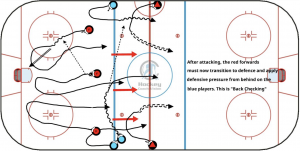
Backhand Shot:
This is a shot that is taken using the backside of a hockey stick blade. Although it is not as powerful as a slap shot or as accurate as a wrist shot, a backhand shot often confuses and deceives a goaltender, making it hard to defend at times.
Source from: Marcel’s Hockey School
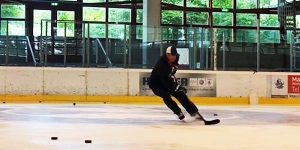
Boards:
In a hockey rink, the boards are the low walls that form the boundaries of the rink. They are between 40 and 48 inches (100 and 120 cm) high. The “sideboards” are the boards along the two long sides of the rink. The half boards are the boards halfway between the goal line and blue line. The sections of the rink located behind each goal are called the “end boards”. The boards that are curved (near the ends of the rink) are called the “corner boards”.
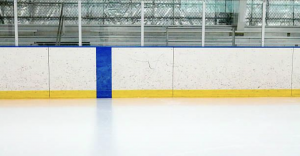
Break Away:
A breakaway is a situation in which a player with the puck has no defending players, except for the goaltender, between himself and the opposing goal, leaving him free to skate in and shoot at will (before the out-of-position defenders can catch him). If a player is fouled from behind while on a breakaway and cannot get a decent shot off, the referee may award a penalty shot to the player who was fouled.
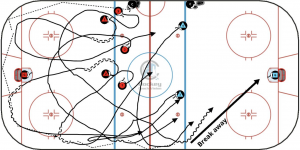
Breakout:
A hockey breakout is when one team gains control of the puck in their defensive end and passes or skates the puck out of their defensive zone. In most cases, breakout needs good team work and coordination between the defencemen and forwards to exit their zone with puck control. A breakout begins once a defender gets possession of the puck and skates away from the opposing team’s players or passes quickly to a teammate. It is important that players support each other, not getting too far apart, to provide several passing options for the puck carrier.
Center (Forward):
The center in ice hockey is t
he forward position of a player whose primary zone of play is the middle of the ice, away from the sideboards. Centers have more flexibility in their positioning and therefore often end up covering more ice surface than any other player. Centers are ideally strong, fast skaters who are able to back-check quickly from deep in the opposing zone. Centers will take face-offs and are generally positioned between their two wingers. They are also expected to have exceptional “ice vision”, intelligence, and creativity. They also generally are the most defensively-oriented forwards on the ice, as they are expected to play the role of the third player in defense, after the defencemen. Centers usually play as part of a line of players that are substituted frequently to keep fresh and keep the game moving.
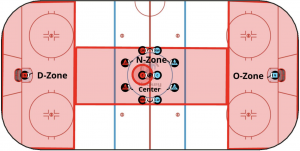
Chip:
“Chipping” a puck can be placing a puck softly (soft dump or passing softly off of the side wall) into a certain area for other players to pursue, making an indirect pass off of the boards to break out of the defensive zone or making an indirect pass off of the boards to break into the offensive zone. In each case, we say that we “chip” the puck softly to an area or off of the wall to an area for a teammate to recover. When chipping a puck off of the boards, you can deaden the bounce of the puck off of the wall by getting the puck up off of the ice onto the white part of the boards. The puck will slow down and land more softly onto the ice.
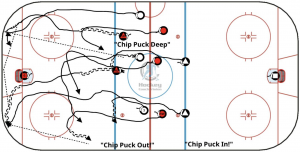
Collapse:
Collapse coverage. This can occur at even strength or on the PK when the players wish to play a more compact style of defence they “collapse” or shrink the size of the covered area to cover the front of the net or play tighter coverage in a corner. In the example shown, we are starting a scrimmage situation from a collapsed D coverage. Practice offensive and defensive escapes from this low scrum. Offense looking for a quick attack off of turnovers and Defense looking for a quick breakout. Normal play follows. Alternate which corner you start in after every line change.
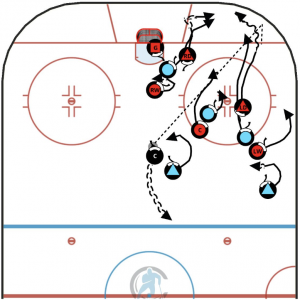
Cycling:
Cycling is when two or more offensive players move in a circular motion, making indirect passes to a teammate who is following behind in the quiet areas in the corner or behind the net to get away from the defensive pressure. This offensive strategy is designed to create time and space as well as tire out the defensive players. In today’s game, positions in the offensive zone are becoming more interchangeable with forwards cycling out to the blue line and defencemen cycling low to take their place. When forwards are cycling the puck low, one forward should always remain above the face-off circle or be skating toward it as a safety valve. If a D cycles deep…a forward should take their place. Cycles occur on the low boards near the end of the offensive zone, in the corners, behind the net and up high close to the blue line. This can be a very aggressive system where all five skaters are part of the attack in the offensive zone. Net cycles are often used to change the point of attack to the other side of the offensive zone.
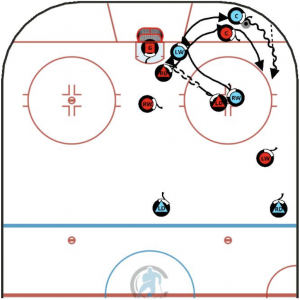
D to D (Pass):
In the first situation LD has moved to pick up the puck, while RD is reading the other team’s position. RD recognizes that the other team has flooded one side of the ice so he calls “OVER” to LD. This tells LD that the best play is to pass the puck behind the net to RD (A direct pass is ideal, but a bank pass can be made as well). In the second example, D1 makes a quick ‘over’ D to D pass to D2 to change the point of attack to the other side of the rink.

Deflect:
When a player re-directs or tips a pass or shot with their stick to change the path of the puck, this is called “deflecting the puck” in Hockey Glossary. This technique is very effective in front of the net as it gives the goalie little time to react to the puck’s change of direction. This technique can be perfected through a lot of practice deflecting shots. D-men should use wrist shots about knee height when shooting from the blue line as these shots are easier to deflect/re-direct/tip.
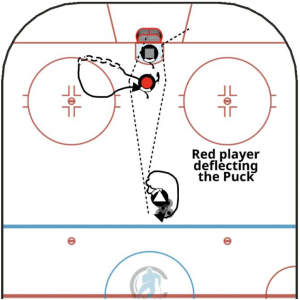
Deking:
In ice hockey, deking is a type of feint or fake technique where a player draws an opposing player out of position or skates by the opponent while maintaining possession and control of the puck. The term is a Canadianism formed by abbreviating the word decoy. To “deke out” the goalie with deking, a shooter will fake going one way to get the goalie moving sideways, then cut back to the opposite side of the net towards the open side. Toe drag: A more complex deke is the toe drag, a deke in which the puck carrier brings the puck forward on their forehand, and subsequently turns their stick and pulls the puck towards themselves with the toe of the blade while moving past the defender, who has presumably attempted to poke check the puck in its previous position.

Delay:
In this example, F2 crosses the offensive blue line but does not have a clear pass or shot option as D2 squeezes F2 toward the wall. F2 makes a quick curl turn up towards the blue line effectively “delaying’ the drive towards the goal to buy some space and time to look for other options. In this case, F2 passes to D3 coming late on the play. On wide entry, drive the puck as deeply as you can down the wall before delaying to allow other players to move into position. One forward drives the middle lane to the net. Lots of talk by defending players on D zone coverage to sort out coverage quickly.
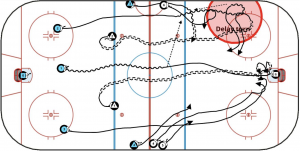
Dots:
Nine dots denominate where faceoffs take place. There are two in the defensive zone, five in the neutral zone, and two more in the offensive zone. The center ice dot starts play at the beginning of the period and after goals are scored. The defensive and offensive zone dots start play after the puck is frozen or sent out of play while in the zone or in the event of an icing. The four remaining neutral zone dots are used in the event of offsides infraction or if the puck is sent out of play while in the neutral zone.

Drop Pass:
This is a type of pass where a player leaves or “drops” the puck directly behind them in an area where a teammate can skate onto it and pick up the puck. A perfect drop pass is where the player releases the puck behind them, where the puck then stops and their teammate is able to skate onto it to shoot it quickly or to continue skating with the puck. The left-wing brings the puck up the ice where he cuts across in front of the defender then does a “drop pass”, where his teammate cuts behind him and picks up the puck.
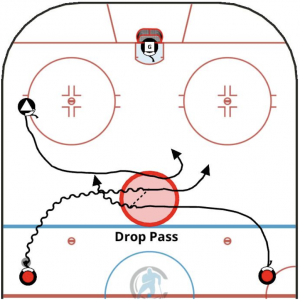
Face-Off:
To start a game, new period, or after a referee stops the game, play can only resume with a new drop of the puck by a referee. This is called a “face-off”. There are eight face-off dots on the ice surface from where a face-off can occur. Players line up on their side of the face-off dot and may not move or enter the face-off circle until the referee drops the puck. Tip: On a middle-ice face-off win against a team with aggressive wingers on neutral zone face-off losses, cut your centerman to the wall to draw their center away from the middle and cut your strong side winger underneath to become a quick pass option for the D Men. Weak side winger heads to the wall as a quick chip-and-go option or for a direct pass.
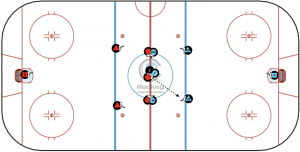
Flat Attack/Flat Pass:
When you make a cross-ice pass from the puck side of the rink (Strong Side) to the opposite side of the rink (Weak Side) where the pass goes straight across without advancing the puck, this is called a “Flat Pass”. This changes the point of attack from the Stond Side, where most of the defenders are, to the Weak side, away from traffic. This is called a “Flat Attack”. Requires great timing and positioning. Move the puck away from the defensive pressure. Effective against neutral zone traps.
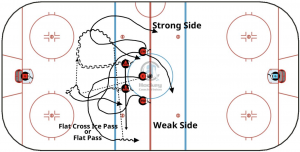
Forechecking:
When the defensive players are putting pressure on the offensive players (they have possession of the puck) deep in the offensive zone, this is called “forechecking”. The goal is to pressure the other team into losing the puck or turning the puck over in their own zone which can lead to quick counter-scoring chances close to their net. There are multiple tactics for forechecking that involve different defensive formations and specific responsibilities for each checking player. This is an example of a 2-1-2 forecheck. F1 hunts the puck and makes contact with their D, F2 reads where the puck is going and provides close support to F1 if there is a loose puck. F3 stays high above the circles to back up the D if they pinch down along the wall on their wingers.
Gap:
The “Gap” is the amount of space between the puck carrier and the defensive player. Defensive players want to limit the space and time they give to the offensive players. When we say that a defensive player has a “good gap”, that means that he is playing very tight coverage on the offensive player, limiting his offensive options, looking to force a turnover and get the puck back.
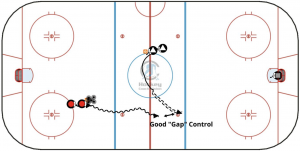
Give and Go:
A “Give and Go” play is when a player passes to a teammate, then moves to a new area to get the puck right back again. The puck carrier gives the puck to a teammate, then goes to get the pass back. This tactic is often used in the offensive zone close to the net to create scoring chances. Once the first pass is made, the passer must move quickly to an unprotected area to get the puck back from his teammate.
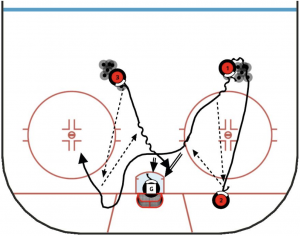
Half board:
The half boards are the boards halfway between the goal line and the blue line. The sections of the rink located behind each goal are called the “end boards”. The boards that are curved (near the ends of the rink) are called the “corner boards”.

Hit:
Hitting in hockey is essentially when a player uses their body to make contact with another player, often with the intention of slowing them down and/or removing the puck from their possession. While hitting can be a valuable tool to gain an upper hand on your opponent, it also has the potential to hurt someone. Countless NHL players have gotten injured over the years from hits that have been illegal or reckless. Hockey is a physical sport, and there are a few different kinds of hits that players can use. When most people think of a hit, the one they are thinking about is a shoulder check. This is when a player leads with their shoulder and collides with the opponent’s chest or shoulder. It is important for the hitter to keep their elbows low and tucked in to avoid contact with the opponent’s head. If the elbow gets anywhere close to the head of the opponent, a penalty will often be called. Another type of hit that will often be seen is the hip check. Players will lead with their hip to knock opponents off balance. This type of hit can stop a player in their tracks and make it very hard to maintain control of the puck.
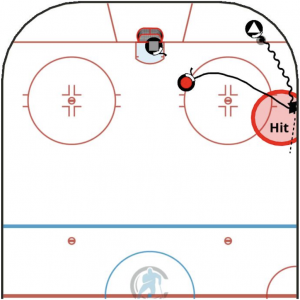
Icing:
When the team in possession of the puck shoots the puck the length of the ice, over the defender’s goal line, before crossing the center ice red line, and the defending team touches the puck before an attacker can or beats the forechecker to the face-off circle, this is called an “icing” infraction. The linesman will whistle the play dead and the next face-off will be back in the offending team’s end zone. A team is permitted to “ice” the puck when playing short-handed in a penalty-killing situation. The object then is to put the puck as far away as possible from their net as possible to let the clock run until their teammate can leave the penalty box to rejoin the play.
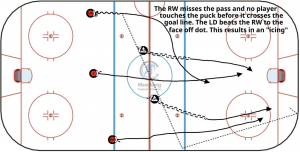
Inside:
Refers to the position of the player in relation to the net and the position of the opposing player or players during play. To get the “inside” position, the player must place themselves in the interior of the play, closer to the net than the opposing player who is then on the outside. Defenders maintain good defensive positions keeping their bodies between the attacking players and their net.
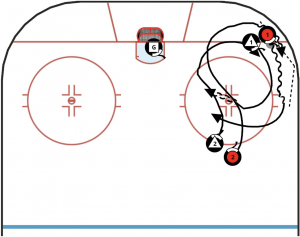
Inside-Out Checking:
“Inside-Out” checking refers to defenders moving from the middle of the ice toward the outside area of the playing surface to force the puck carrier-wide toward the boards. F1 finishes his check on their D. F2 jumps back hard through the middle-to-back check. F3 forces the puck carrier wide from his inside position in the good ice.

Left Winger & Right Winger (Forwards):
The Winger, in hockey glossary, is the forward position of a player whose primary zone of play is along the outer playing areas. They typically flank the center forward. Originally the name was given to forward players who went up and down the sides of the rink. Wingers generally have the least defensive responsibilities out of any position on the ice, however, they are still tasked with defensive duties such as forechecking duties or covering the point in the defensive zone. This position is commonly referred to by the side of the rink that the winger normally takes, i.e. “left-wing” or “right-wing.” The side of the rink the player played on is traditionally related to the side of their body they take a shot from (i.e. left-shooting playing left wing) but in recent decades more wingers have played the “off wing” meaning the opposite side of the direction they shoot, which enables faster release shots if receiving a pass while standing stationary in the offensive zone.
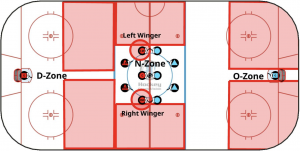
MVP:
MVP is an acronym for “most valuable player”. It is a term used in team sports for players who are extremely valuable to their teams and always do well in games. In texting, calling someone an MVP means they did especially well at something. The Hart Memorial Trophy, originally known as the Hart Trophy, is an annual award for the most valuable player in the National Hockey League (NHL), voted by the members of the Professional Hockey Writers’ Association. The original trophy was donated to the league in 1923 by David Hart, the father of Cecil Hart, the longtime head coach of the Montreal Canadiens. The Hart Trophy has been awarded 99 times to 61 different players since its beginnings in 1923–24.
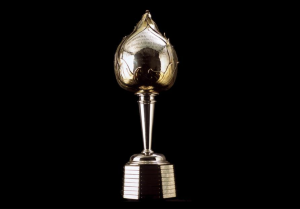
Net Cycle:
Cycling is when two or more offensive players move in a circular motion, making indirect passes to a teammate who is following behind in the quiet areas in the corner or behind the net to get away from the defensive pressure. This offensive strategy is designed to create time and space as well as tire out the defensive players. In today’s game, positions in the offensive zone are becoming more interchangeable with forwards cycling out to the blue line and defencemen cycling low to take their place. When forwards are cycling the puck low, one forward should always remain above the face-off circle or be skating toward it as a safety valve. If a D cycles deep…a forward should take their place. Cycles occur on the low boards near the end of the offensive zone, in the corners, behind the net, and up high close to the blue line. This can be a very aggressive system where all five skaters are part of the attack in the offensive zone. Net cycles are often used to change the point of attack to the other side of the offensive zone.
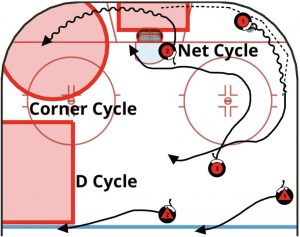
Off-Side:
When entering the offensive zone, the puck must precede any offensive player entering the offensive zone. Should an offensive player enter the offensive zone before the puck crosses the blue line, the play would be whistled dead by the linesman and a face-off would occur just outside of that blue line in the neutral zone. If a puck goes out of the offensive zone, and the offensive players recover in the neutral zone and shoot it back in, the players trapped in the offensive zone may touchup outside of the blue line and re-enter the zone after all attacking players have exited the offensive zone. Play can continue from this point without any off-side infraction.

One-timer:
A “one-timer” shot occurs when a player receives a pass from a teammate and shoots it immediately without stopping to handle the puck. The most common shot from this is a slap shot but you can also one time a snap shot. One-time shooting is very effective for scoring as it leaves the goalie little time to adjust his positioning and it is also harder for them to pick up the shot direction of the puck coming off of the shooter’s stick.
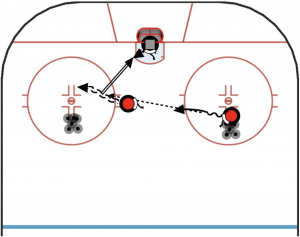
Overload:
Whenever you “overload” an area on the playing surface, you are trying to create a numerical advantage by having extra players in the area whether it be on offence or defence. Here is an example of a power play setup that sets up concentrating most of the players in one area of the ice to outnumber the defenders. When you overload an area when defending, the idea is to get the puck back as quickly as possible. On offence, when overloading, the goal is to create space and time where there are not enough defenders to cover all of the attacking players.
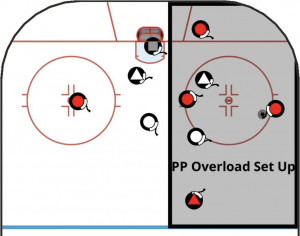
Penalty killing / Box-play:
When a player is penalized, they must leave the ice surface and sit in the penalty box, feeling shame. His team is now described as being “shorthanded”. To “kill” the penalty, his teammates must play with a reduced number of players until the penalty time has expired and the penalized player returns to the ice. The defending players are called “Penalty Killers”. While “killing” the penalty, the defending team may shoot the puck all the way down the ice without this causing an “icing” situation. The defending team must have at least 3 skaters on the ice plus a goaltender no matter how many penalized players are in the penalty box.
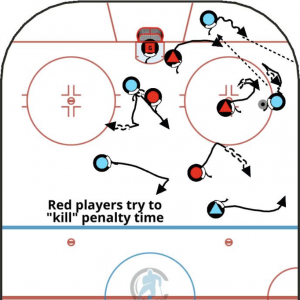
Pinching:
When a defending player, most often a defence-man, moves forward from the blue line in the offensive zone to confront an attacker along the boards we call this a “Pinch”. The goal is to keep the puck in the attacking zone and not let the opposing team out. This often creates turnovers where the defender’s forwards can recover the puck and continue attacking. This is a risky maneuver so the defenceman must use good judgment when deciding to pinch or not. Pucks that get past a pinching D can result in an odd-man attack going the other way. As a general rule, a defenceman can only pinch when they have a supporting player in position to back them up should the puck/player get past them. No support? No pinch.
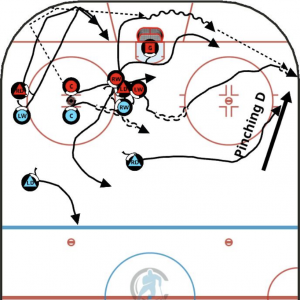
Point-man:
The point in hockey is often used to reference defencemen, a defence-man’s position, or even just the blue line. This is often why you will hear announcers say that they passed the puck to the point, that a player is a particularly good point man, or that a shot was taken from the point. A good point player will be mobile, have a good shot, excellent play-making skills, and good vision. When the point player gets the puck..the player moves, the puck moves, or is shot. Good point players are never static with the puck.
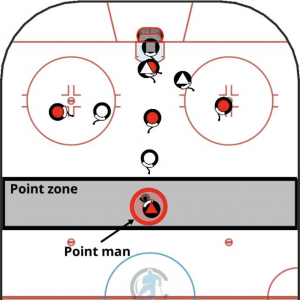
Power Play:
When one team is penalized, the brute who created the foul is removed from the ice and the other team gets to play with one player more than the defenders. The attacking team is now on the “power play.” Should the power play score, the offending brute may return to the ice, and play continues 5v5. It is considered a “power play” when the attacking team is playing 5v4, 5v3 or 4v3. When a player in hockey receives a penalty, he must go to what is called the “penalty box” aka “The Sin Bin” and sit there for the designated amount of time based on the penalty he has incurred. The majority of the time the penalty is for 2 minutes, however, they can also receive penalties of 4, 5, or 10 minutes in length for severe infractions.
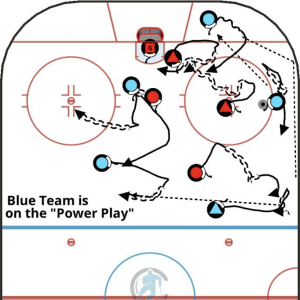
Quick Up:
An effective “quick up” pass is a great way to get on the attack quickly and catch the opposition off guard. After recovering a loose puck deep in the defensive zone or after a neutral zone turnover, quickly advance the puck toward the opposition zone with a forward-moving vertical pass. This can be done from your own defensive zone, or in the neutral zone. Communication is key to playing fast-paced hockey. Defenders retreating to pick up a puck deep in their zone should be checking over both shoulders to see where the forechecking pressure is and to locate their own players for quick pass options. It is a great help to the defender if an open player calls to him to get their attention and let them know that they are a quick option.
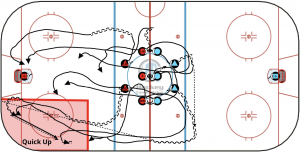
RD & LD (Defensemen):
Defence-man or defensemen (in American English) in ice hockey is a player position that is primarily responsible for preventing the opposing team from scoring. They are often referred to as defensemen, D, D-men or blueliners (the latter a reference to the blue line in ice hockey which represents the boundary of the offensive zone; defensemen generally position themselves along the line to keep the puck in the zone). They were once called cover-point. Defensemen need to be strong backward skaters and tenacious checkers. In the modern game, D-men are increasingly involved in the offensive part of the game as well. The greatest D-man of all time is Bobby Orr.
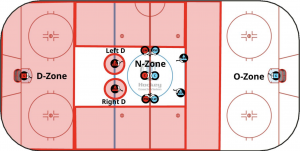
Rebound:
A “rebound” is a puck that remains in play after a save by a goalie or deflecting off of another player. A rebound can even occur off the board or the net. Sometimes after a save, the puck will rebound back into play creating an excellent scoring opportunity. A player can then take advantage of the goalie being out of position to score. Practicing scoring from a rebound is a key offensive tactic in hockey. Get out a little further from the goalie. The edge of the face-off circle is a good place to position yourself for a rebound. Have your stick on the ice ready to shoot immediately. When screening, turn as soon as you lose sight of the puck to hunt for the rebound. Pre-load your stick. Study how the puck comes off the goalie’s pads. It’s just like geometry but way more fun.
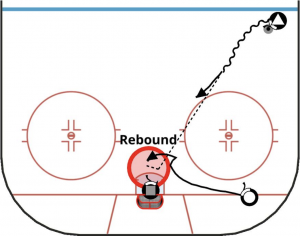
Reverse:
Using a “Reverse” is a great way to relieve oncoming pressure. Suck one of the opposition players out of position by skating in one direction, then use a backward bank pass or drop pass to a teammate with more time and space. This is an example of a “D to D Reverse”. Reverse passes can also be made to the center coming in late, where the D fakes a D-to-D pass and then banks the puck off of the wall the opposite way to the center. This is called a “Center Reverse.”
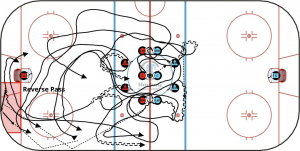
Rim:
When you “rim” the puck, you fire the puck along the wall in the corner using the shape of the corner to bend the pass around the defenders and onto a teammate. This is an example of a D-man using a rim pass to beat the forechecker. You may also use a “rim” when shooting the puck into the offensive zone to start a forecheck. This kind of rim should be hard and high on the plexiglass to beat the goalie who will try to cut off the puck. This gives the forechecking forward on the other side of the rink more time to get onto their D-man and force a turnover. It makes it tough for the D to pick the puck up off of the wall under pressure.

Rink:
The official size of the Rink shall be 60 m (197 ft) long and 26 m to 30 m (82 ft to 98 ft, 5 in) wide. The corners shall be rounded in the arc of a circle with a radius of 7.0 m to 8.50 m (23 ft to 28 ft). Any deviations from these dimensions for any IIHF competition require IIHF approval.
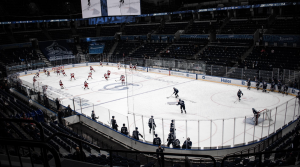
Rookie:
In sports, a rookie is a professional athlete in their first season (or year). In contrast with a veteran who has experience, a rookie is typically considered to need more training and learning, though they may bring new outside expertise to a job. To qualify as a rookie in the National Hockey League, a player must not have played in more than 25 NHL games in any preceding seasons, nor in six or more NHL games in each of any two preceding seasons. Any player at least 26 years of age (by September 15 of that season) is not considered a rookie.

Roster:
Roster is a term used in lots of sports, hockey included, defined as the official manifest of players on the team. These players are the ones who will be dressed and playing in the game. Both the 20-player roster and the 23-player roster can be changed day-to-day and game-to-game. Any changes made to the rosters must be cleared and approved by the NHL Central Registry.
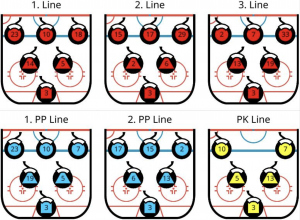
Saucer pass:
The saucer pass is an ice hockey technique in which the puck is passed to another player in such a way that it flies in the air like a flying saucer. This makes the pass more difficult to intercept by opposing players but it will still land flat on the ice making it simple to control for the receiving player. Feel the puck. Be focused
Source from Mountain High Hockey
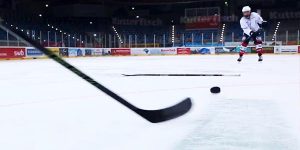
Screening:
When a player purposely stands in front of the goalie to mask his view, we call this a “Screen”. The word can also be used as a verb, commonly “don’t screen the goaltender”, or “the goalie was screened”. A “Screen Shot” is a shot taken when the goalie’s view of the puck is obstructed. It can be an attacker that is screening or one of the defenders can screen as well if they are out of position. The player that screens should try to tip the puck on the way by and then spin around to look for a rebound. The key is to screen the release of the shot. This is the part of the shot where the goalie needs to see to pick up the speed and direction of the shot.

Shooting Techniques:
In ice hockey, a shot on goal is a shot that directs the puck towards the net and either goes into the net for a goal or is stopped by the goaltender for a save. A shot that is deflected wide or blocked by an opponent does not count as a shot on goal; it is recorded as a blocked shot. The player who blocks the shot is credited with a ‘blocked shot’, and the player who shoots the puck is credited with an ‘attempt blocked’. Shots that sail wide or high of the net, and shots that hit the goalpost or crossbar but do not enter the net, are not counted as shots on goal; they are counted as ‘missed shots’. Additionally, if a goaltender stops a puck that is going wide or high anyway, it is recorded as a ‘missed shot’. Since it is not counted as a shot on goal, the goaltender does not get credit for a save.
Types of Shot:
1.WRIST SHOT – While the slap shot gets the attention, the wrist shot lights the lamp—with about half of all goals scored coming off wrist shots. The wrist shot can still send a puck sizzling with a sweeping motion combined with a quick snap of the wrists.
2. SNAP SHOT – The snap shot is a combination of the wrist shot and slap shot. Draw the blade of the stick away from the puck a short distance then accelerate back into the puck, snapping your wrists on contact.
3. SLAP SHOT – The slap shot is hockey’s rock star. It’s also the shot that most players want to practice and take during games, but its success rate in scoring goals actually falls to third or fourth place among the four types of hockey shots. Draw the blade of your stick back up above your shoulders then bring it back to the puck quickly, catching the ice just before contact with the puck, snapping your wrists on contact for maximum power and speed.
4. BACKHAND SHOT – Backwards wrist shot!
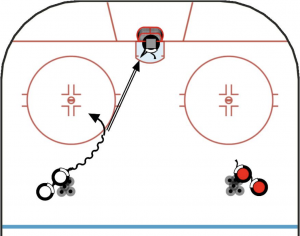
Slot:
The “slot” is the area on the hockey rink directly ahead of the goaltender between the faceoff circles on each side. This is the prime scoring area. A shot from anywhere within this area is called a “slot shot”. The “deep” or “high” slot refers to the area from the top of the circles, furthest from the goaltender, down to the “hash marks” (the short lines on the side of the face off circle).In general, it is the defence man’s responsibility to guard offensive players in the lower slot, closest to the goaltender, while the weak side winger or centre cover offensive players in the high/deep slot.
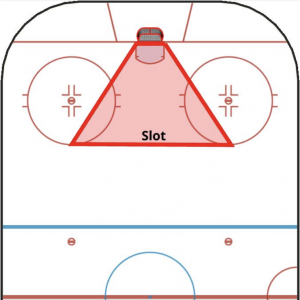
Steering:
To “steer” a player in hockey glossary is to influence an attacking player, with your skating and body position, to get the puck carrier to move in the direction you wish him to go. In the example shown, the F “steers” the D out from behind the net onto the D’s backhand, making it harder for the D to make a breakout pass. The F takes away the “good ice” and forces D wide into the “bad ice.” Good timing and body position. Good stick position to take away passing options into the middle of the rink (the good ice). Good angling technique once the player starts to move in the desired direction.
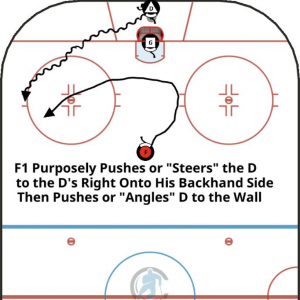
Stretch Man:
On this break out play from a defensive zone face off, Red Player LW (Left Winger) is the stretch man in this play. His job is to slash across on an angle in front of the two blue defencemen to push them back or ‘stretch them out.”. This creates space for the other red players coming behind him. Timing is crucial for this play to be effective. The LW does not want to leave to soon in case there is a turnover in his zone, but has to leave early enough to push the two blue D backwards to create space and time for his teammates following behind. The “Stretch-man” is sometimes called the “Push the Pace” player.
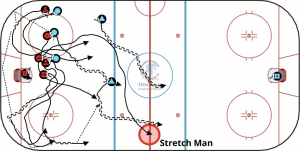
Support:
Players should stay compact in their formation most of the time so that they can help or “support” each other by providing passing options while attacking or provide another layer of defence when defending. While attacking, it is always advantageous to create 2v1 situations where you can outnumber the defender. Providing close support to the puck carrier helps create space and time for the puck carrier. When you can see “five in the picture” this means that you can see all five skaters in a video image. This demonstrates that the players are supporting each other.
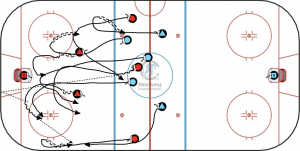
Trailer:
The “Trailer” is the player coming late on the play and supporting the puck carrier from behind. This allows at least one of the forwards to drive the middle of the ice directly to the net for a screen, tip or rebound scoring chance.
This type of attack creates multiple passing options after a wide entry into the offensive zone. Defencemen often jump up into the play to become the 3rd or 4th player on the attack creating a numerical advantage during a rush up the ice. A player that is coming late on the play should “get loud” to let the puck carrier know that they are open.
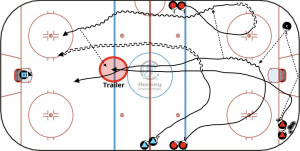
Trap:
In hockey, traps happen when the ice is “clogged” with defensive players, making it harder for the attacking team to move up the ice. Traps in ice hockey are typically used when the defence feels outclassed on offence by their opponent. First player needs to steer. Second player tries to close the board or passing lanes.
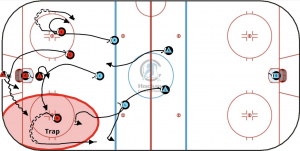
Umbrella:
“Umbrella” in Hockey Glossary refers to the shape of the player’s formation on the ice. In this example we see an example of an Umbrella Power Play set up, with three players up high and two player lined up in the middle of the ice. This forms an upside down “umbrella”. This formation spreads out the four defenders and makes it harder for them to pressure the attackers. Tape to tape passes. Quick passes to create space for shots. One time shots.
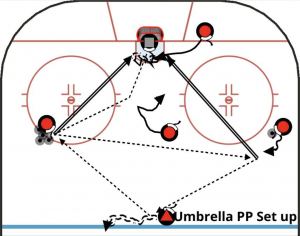
Unit / Line:
A hockey “line” may refer to three forwards who play together or a group of five teammates that play together on the ice at the same time. The coach decides how he would like to combine his players. Normally, there are three forwards, two defencemen and one goalie on the ice. Some teams have four complete lines (4X5 players) sometimes called “blocks of players” on the roster along with two goalies, 22 players. Mostly though, coaches mix and match their players. Substitutions, or line changes as they are called in hockey, usually happen during live action, while the puck is in play. In some leagues, the number of players permitted on the score sheet is limited to 20 players or less, so the formation might have four forward lines, six defensemen and two goalies. The coach decides what players are on the ice at any given point in a game. The players on the bench are told who is up next so that when a player leaves the ice, his replacement automatically jumps in to replace him. If things are not going well in a game, a coach may decide to change his lines mid game or “juggle” his lines.
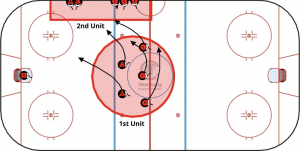
Zone Entry:
“Zone Entry” usually refers to when the attacking team enters the offensive zone. The puck must cross the offensive blue line before any member of the attacking team can enter the offensive zone. Should an attacker precede the puck, this would be considered “off side” and the linesman would whistle to stop play. Avoid offside positioning. Entries in the middle of the ice create more options. Off of a wide entry, where the puck enters the offensive zone near the boards, there should always be at least one forward driving down the middle of the ice towards the front of the goal.
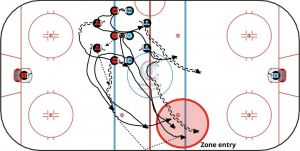
Where can I access the Hockey Glossary?
To access the Hockey Glossary, simply sign in to your HCV app (whether in a Player, CoachLimited, or Coach Account) and find the package in the FREE folder. If you don’t have an app yet, Download it here and register your FREE Player or CoachLimited account when the app starts.
Currently, the Hockey Glossary contains 65 files, (Forechecking, Backchecking, Breakout, Deking, etc.) but we are constantly adding more. If you have any suggestions for a term we are missing, always feel free to get in touch and submit the file that you think our Hockey Glossary is missing! All of the Hockey Community will appreciate your contribution!
Thanks, your Hockey Coach Vision – Team!
Check out our website and Follow us here for more Free Drills.

